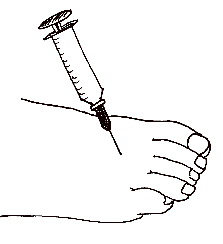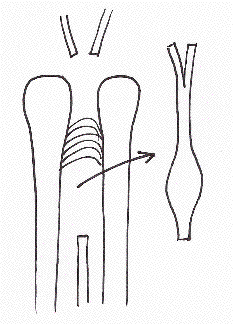Le névrome de Morton
Beaucoup de personnes souffrent d’une surcharge chronique de l’avant-pied. Les causes sont multiples, on peut en particulier mentionner :
-
la raideur de la cheville, surout en cas de raccourcissement du tendon d’Achille
-
porter des hauts talons de façon prolongée
-
l’excès de poids
-
des facteurs héréditaires
Cette surcharge peut donner lieu à différents problèmes, notamment l’hallux valgus et les orteils en griffe.
Parfois cette surcharge touche les nerfs qui cheminent dans la plante du pied, entre les os métatarsiens :

sur l’image de droite, on voit à gauche un nerf plantaire normal, qui passe dans un petit "tunnel" fibreux entre deux métatarsiens ; sur la droite, par contre, le nerf est agrandi et ne fonctionne plus correctement, car le tunnel est devenu trop étroit. C’est ce renflement du nerf qu’on appelle le névrôme.
Symptômes
Les patients souffrant d’un névrome de Morton se plaignent de douleurs sous l’avant-pied en un point précis, accompagnées parfois de fourmillements dans les orteils voisins ; certains ont la sensation d’avoir une "boule" sous le pied. Les douleurs sont en général aggravées par des chaussures serrées, et après de longues marches.
Traitement
Supports
Le traitement est tout d’abord simple : il faut absolument essayer de porter pendant quelques mois des supports plantaires, qui soutiennent le pied un peu en arrière des points d’appuis normaux, et ainsi déchargent l’avant-pied d’une partie du poids du corps. Ce traitement peut diminuer, voire supprimer les douleurs si elles ne sont pas trop graves, ou si elles ne sont pas présentes depuis longtemps.
Infiltration
Si les douleurs continuent malgré les supports plantaires, on peut essayer une infiltration : il s’agit d’injecter une petite quantité de cortisone autour du névrome.

la cortisone, un anti-inflammatoire puissant, peut diminuer les douleurs et l’inflammation.
Opération
Quand les traitements dits "conservateurs" ont échoué, le traitement chirurgical est une bonne option : l’opération est simple, elle consiste à enlever le nerf qui est dégénératif et ne fonctionne plus correctement. On enlève ainsi la cause du problème. Il y a un relatif inconvénient : la sensibilité des faces répondantes des 2 orteils concernés diminue, voire disparaît suite à l’opération.
L’opération peut se faire par voie dorsale ou plantaire. Elle se fait généralement en ambulatoire.

Sur le schema ci-dessus, on peut voir quelle partie du nerf est enlevée lors de l’intervention.La rééducation à la marche est simple, il n’y a généralement pas besoin de physiothérapie. L’appui sur l’avant-pied est douloureux au début, nécessitant parfois l’usage d’une canne anglaise pendant quelques jours. Les douleurs diminuent ensuite progressivement sur plusieurs semaines.


